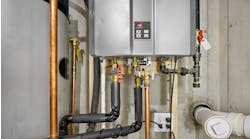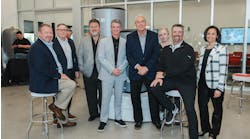By Dave Yates
Plumbing Contractor
Water heater thermal efficiency represents the potential percentage of energy an appliance can move from itself into a given system while operating. Energy factor ratings tell a different tale regarding operating efficiencies because the EF includes associated energy losses — including those that occur when the unit is not operating. Lifecycle costs incorporate expenses for equipment, labor, fuel, maintenance and replacement.
Often, the first question I get asked when talking about our recently installed solar system is, "How can you justify the expense for installing solar for domestic hot water systems?"
There's no question a solar hot water system is a relatively expensive investment, especially when compared to a number of alternative water heaters.
For the sake of argument, let's assign a $10,000 installed cost for our 30-vacuum-tube Viessmann solar system and we'll include an annual maintenance budget of $40. Electricity for the controller and pump will be generated by a small photovoltaic panel. Subtract $2,000 federal tax credit (maximum of 30% or $2,000) for a net installed cost of $8,000.
The major components are rated to last an average of 35 years. Standard tank-type water heaters are said to last 13 years while tankless manufacturers often claim a 20-year life span.
EF ratings are all over the map!
For our calculations, let's assume a 50-gal./day hot water draw with an average ∆T (temperature difference) of 80°F, which equals 33,320 Btu per day (8.33 lb. x 80-∆T x 50 gal. = 33,320 Btu). EF factors, used in calculations below, were collected from manufacturers' Websites and literature.
Pin the tail on the donkey: Fuel costs vary considerably and fluctuate wildly; labor costs and overhead will continue to rise; costs for goods will increase each year; and installed pricing used within this column is estimated. Let's assign a 5% annual increase for each category. No doubt the actual costs will vary, but one thing's for certain — the costs won't be going down! Given the changes we've seen over the past three decades, 5% seems to be a fairly conservative number to use. Overhead and labor costs, in businesses like ours, are spiraling upwards at rates greater than 5% annually.
The math isn't too complicated: Btu content of a given fuel multiplied by the EF renders the net energy input. Divide that into our 33,320 Btu-perday usage and multiply by 350 days to obtain a year's operating cost.
For example: 1 Watt = 3.414 Btu and 3.414 x .93 EF = 3.17502 net Btu per Watt; 33,32 ÷ 3.17502 = 10,494.42W. 10494.42 ÷ 1,000 = 10.494 kWh and if our fuel cost is 10 cents per kWh, the daily total will be $1.05 or $383.05 per year.
Here are the numbers for an electric tank-type water heater:
- $850 installed cost in 2007;
- .93 EF;
- First-year operating cost = $383.05 if electricity is 10 cents per kWh;
- Add $20 toward an ongoing maintenance budget.
- Our first-year total comes to $1,253.05;
- Our second-year operating cost and maintenance fee will increase from $403.05 to $423.20;
- By the time year 2018 comes to a close, we'll have spent $7,265.40;
- In the year 2019, we'll be installing a replacement for $1,526.48 and by the year 2032 that same model will be installed for $2,878.40; and
- Our total life-cycle cost by the year 2041 will be up to $41,723.47.
Comparable numbers for an electric tankless style are:
- Installed in 2007 for $1,600;
- .98 EF;
- Replacement cost in the year 2027 of $4,245.20; and
- Total life-cycle cost by the year 2041 will be $40,544.96. And for an oil-fired heater:
- $1,600 installed cost in 2007;
- .58 EF and .85 TE;
- First-year operating cost = $388.59 if No. 2 fuel oil is $2.25 per gal.;
- Add $80 toward an ongoing maintenance budget for an annual clean and tune;
- Our first-year total comes to $2,068.59;
- Our second-year operating cost and maintenance fee will increase from $468.59 to $492.02;
- By the time year 2018 comes to a close, we'll have spent $9,058.61;
- In the year 2019, we'll be installing a replacement for $2,873.37 and by the year 2032 that same model will be installed for $6,915.11;
- Our total life-cycle cost in the year 2041 will be $52,290.29; and
- Upgrade the EF from .58 to .66 and our total life-cycle costs would be $48,428.37.
For a propane-fired tank-type unit the numbers are:
- $950 installed cost in 2007;
- .63 EF and .84 TE;
- First-year operating cost = $431.09 if propane is $2.05 per gal.;
- Add $20 toward an ongoing maintenance budget for an annual clean and tune;
- Our first-year total comes to $1,401.09;
- Our second-year operating cost and maintenance fee will increase from $451.09 to $473.65;
- By the time year 2018 comes to a close, we'll have spent $8,130.07;
- In the year 2019, we'll be installing a replacement for $1,706.06 and by the year 2032 that same model will be installed for $3,217.04; and
- Our total life-cycle cost in the year 2041 will be $46,688.48.
- We're just getting started. We'll continue this next month.
Dave Yates owns F.W. Behler, a contracting company in York, Pa. He can be reached by phone at 717/843-4920 or by e-mail at [email protected].

